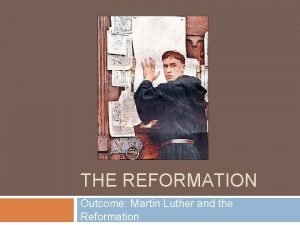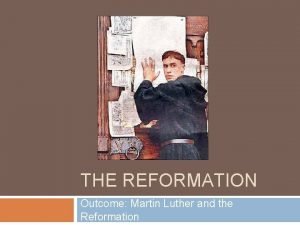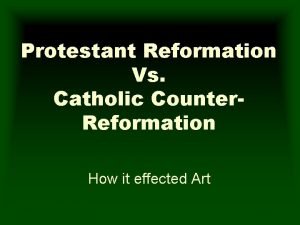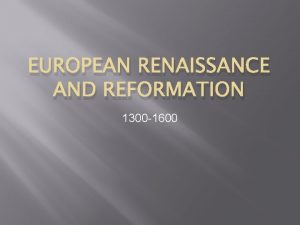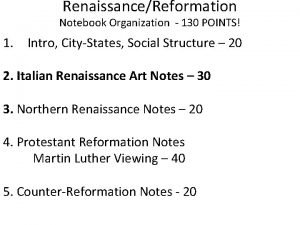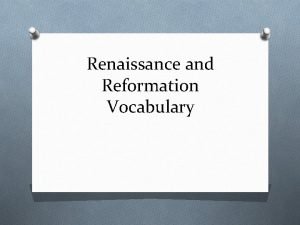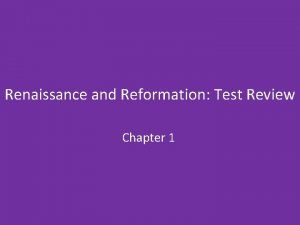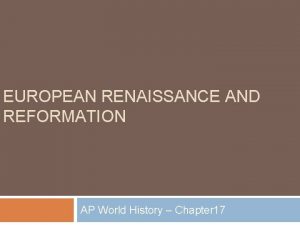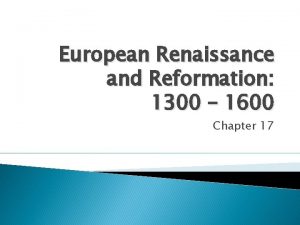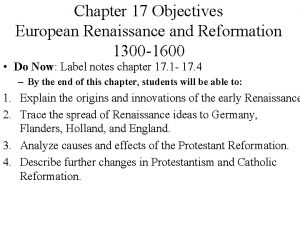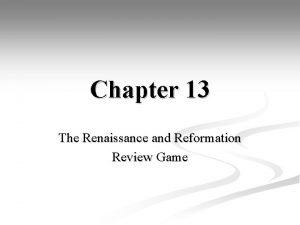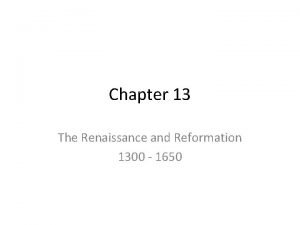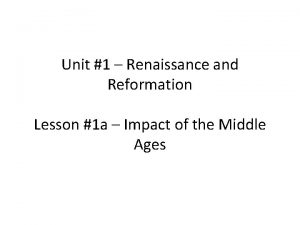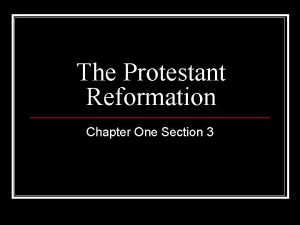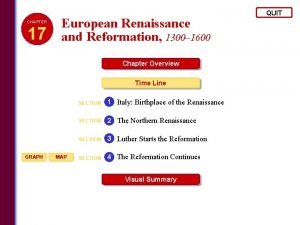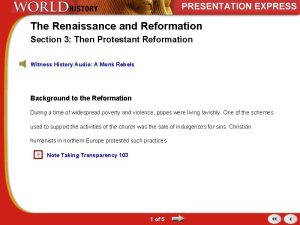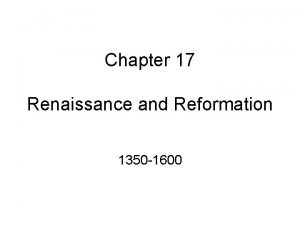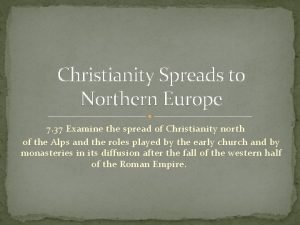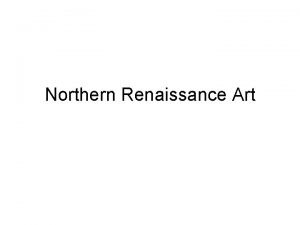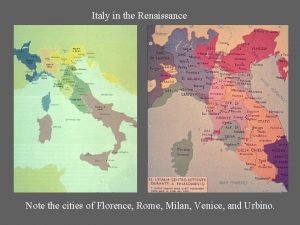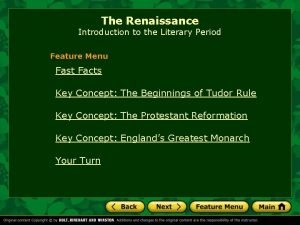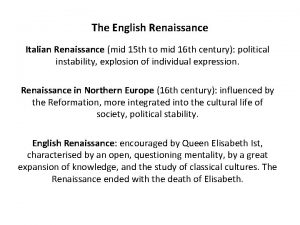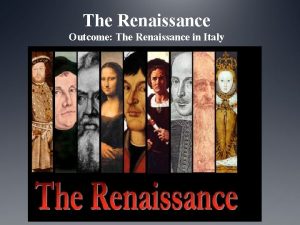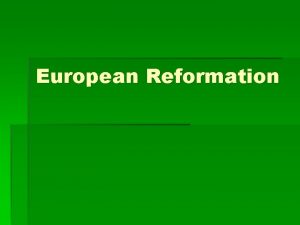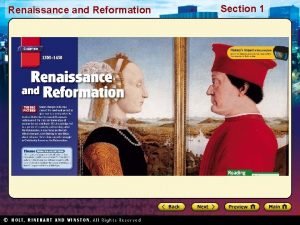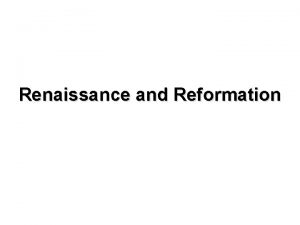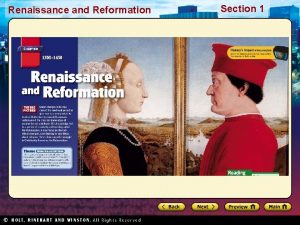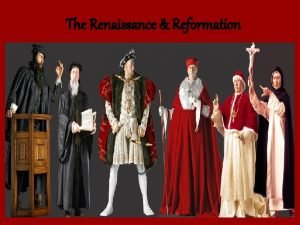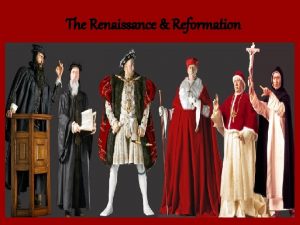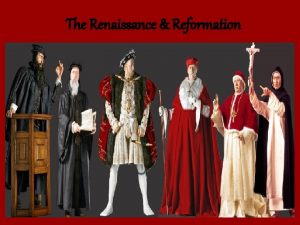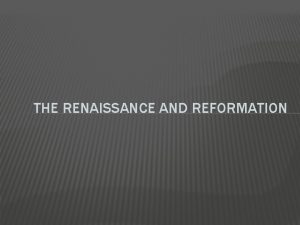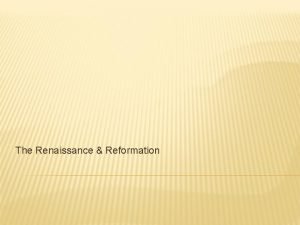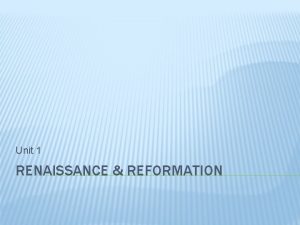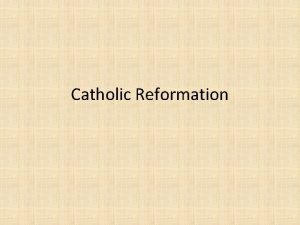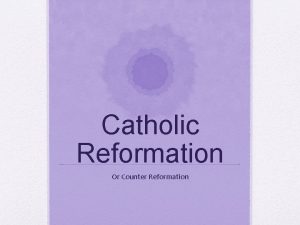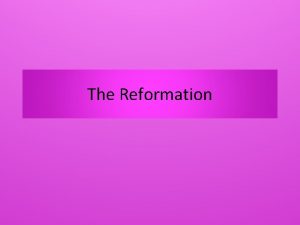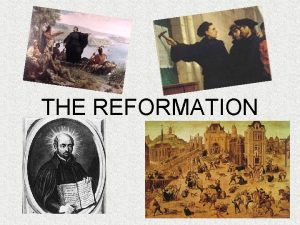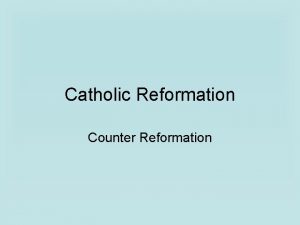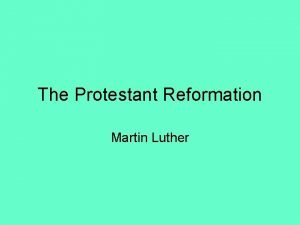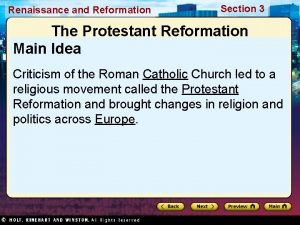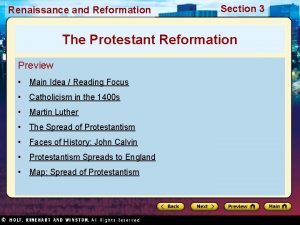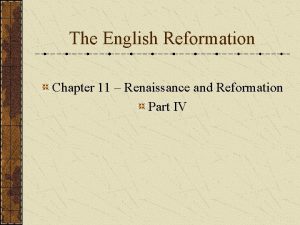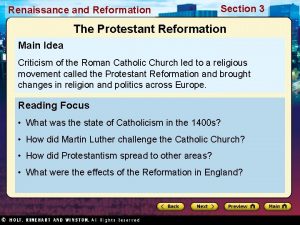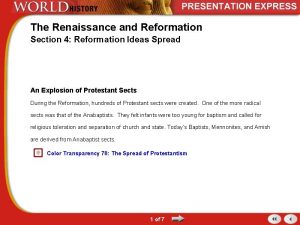The Renaissance and Reformation The Renaissance and Reformation















































- Slides: 47

The Renaissance and Reformation

The Renaissance and Reformation • Renaissance- “rebirth” – Philosophical and artistic movement beginning in the 1300 s – Renewed interest in ancient Greek and Roman literature and life – Movement by the Church to teach the humanities in their scholastic education – Became known as “Humanism”

Humanism • Placing an emphasis on teaching individualism and achievement • Humanists believed that the potential of the human mind was almost limitless

Why the Renaissance now? • The plague, starvation, and wars had overtaken Europe in the 1300’s • Loss of life was enormous- led to changes • Now more food than needed, so food prices decreased • Allowed people more money to buy other things • Also allowed areas to begin to specialize in making things, which led to increased trade of not only goods, but also IDEAS

The Renaissance Admiration for individual achievement Lead a meaningful life Renaissance Thought Supporting the arts Belief in human Education important, critical dignity approach

Niccolo Machiavelli • The Prince – How the government worked – Advice for rulers

Michelangelo • Painter and poet


Leonardo da Vinci • Architect, engineer, painter, sculptor, and scientist

Printing • Already invented in China • Finally, in 1450 Johannes Gutenburg uses moving type to print books • If printing was never developed, how would life be different?

Shakespeare • Portrayed the reality of human personality and emotion

Reformation- Renaissance also led to changes in the Church (reform) • Many believed the Roman Catholic church had lost sight of its spiritual mission – Seemed more interested in income than saving souls

Reformation • Martin Luther – Read about him on page 450 • Formed Protestant group – Had a large following – Believed people could interpret scripture for themselves – Published 95 theses (chapters) about reforming the church and nailed them to the church door in 1517

Martin Luther • Why would Catholic church leaders not be fond of Luther? • Many people read Luther’s theses and this led to the desire for change or reform (“Protestant Reformation”) • Luther was excommunicated (kicked out of the church) in 1520 • Charles V, the Holy Roman Emperor, handed down the Edict of Worms • This declared Luther an outlaw and condemned his writings

Reformation • John Calvin (1536) – Shared many of Luther’s beliefs – Believed in Predestination • People were predestined for salvation

Reformation • Catholic Counter. Reformation – To stop the spread of Protestantism – Returned emphasis to spiritual matters – Made teachings more clear – Ended abuses (indulgences to buy sins)

Counter Reformation • Pope Paul III recognized the need to redefine the doctrines of the Catholic church (result of the Reformation) • He held a council in 1545 - Council of Trent • Council of Trent- addressed the abuses that had weakened the church and also rejected the Protestants

Counter Reformation • The response to the Reformation (the Counter Reformation) also led to other things • Popes established the Roman Inquisitionmeant to counter the Reformation • They charged people accused of teaching against the Church • The harshest of these “inquisitions’ was the Spanish Inquisition

Spanish Inquisition • Spanish Kings tried to establish religious uniformity • Passed the “Index of Forbidden Books” which banned religious texts of Jews, Muslims, and Protestants

Results of the Reformations • Different churches in Europe • Renewed interest in education • Increased power of national government • Decreased power of popes

Age of Exploration

Why explore now? • During the Renaissance a spirit of discovery and innovation had emerged in Europe • People were beginning to question the norm more than ever (was the world flat? ) • Led many European powers to look for new lands or new routes to places already known

Portugal • First country to launch large scale voyages • Henry the Navigator: (Prince Henry) – Not an explorer – Brought in sailors, mapmakers, astronomers, and others to a court – Explore coasts of Africa • Bartolomeu Dias: – First European to attempt to sail around southern tip of Africa (Cape of Good Hope) • Vasco Da Gama: – Sailed from Portugal to India and back successfully • Pedro Cabral: – Discovered Brazil • In India the Portugese set up a trading center and became one of the richest most powerful countries in the world

Spanish • Christopher Columbus: – “ 1492 sailed the ocean blue”: Enough Said • Amerigo Vespucci: – Sailed along coast of S. America – Explained how Columbus was wrong and the land was not Asia but a new land – Mapmakers named the Americas after him • Vasco Nunez de Balboa: – First known European to see Pacific Ocean • Ferdinand Magellan: – – Decided to sail west around world 5 ships and 250 men Killed in the Philippines but men sailed on 18 survivors made it back to Spain and became first to circumnavigate the world

English • John Cabot: – Sailed to present day Canada • Thought it was Asia as well • Sir Francis Drake – English queen sent him to explore west coast of S. America – Stopped in California – Sailed north but too cold so went west – 2 nd man to circumnavigate the world • Henry Hudson: – Goal: find shorter route to Asia – Sailed north but found nothing

French • Jacques Cartier: – Sailed into St. Lawrence River – Claimed land for France (Canada)

Dutch (Netherlands): • - Henry Hudson (same as English) • Sailed to N. America twice • Found Hudson Bay and river

Conquest and Colonies Main Idea The countries of Europe established colonies in the lands they had discovered but, in some cases, only after violently conquering the native people who lived there.

Spain Builds an Empire • Scramble to establish colonies and empires in new lands • Spain first to successfully settle in the Americas • Eventually conquered native empires, the Aztecs and Incas Spain in Caribbean • First areas settled by Spanish, Caribbean islands, Hispaniola, Cuba • Columbus hoped to find gold, did not • Spanish introduced encomienda system there Encomienda • Colonist given land Native Americans to work the land • Required to teach native workers about Christianity Millions Died • Disastrous system for Native Americans • Mistreatment, overwork took toll on population • Europeans spread new diseases

The Conquest of Mexico Conquistador • Some Spaniards moved from Caribbean to mainland to set up colonies • Hernán Cortés led expedition to Mexico, ended with conquest of Aztecs • Cortés a conquistador, military leader who fought against Native Americans Cortes Marches on Capital • Moctezuma II, Aztec emperor at time of Spanish arrival in Mexico • Aztecs powerful, ruled much of Mexico; unpopular with those they conquered • Cortés joined by thousands of those who wanted to defeat Aztecs Other Advantages • In addition to Native American allies, Cortés had metal weapons, heavy armor, guns, horses—animals never seen before in Americas • Disease also swept through Aztec Empire, killing thousands of people

Aztec Empire November 8, 1519, Cortés, army entered Tenochtitlán, Aztec capital • Cortés, Moctezuma greeted each other respectfully • Spanish soon took emperor prisoner – Battle erupted – Moctezuma killed • Months of heavy fighting followed – Cortés eventually took city – Defeated entire Aztec empire

The Conquest of Peru Francisco Pizarro • 10 years after conquest of Aztecs, Francisco Pizarro led expedition to Peru • Had heard of fabulous wealth of Inca Empire; hoped to win wealth for himself New Ruler • 1532, new ruler, Atahualpa, agreed to meet with Spanish • Pizarro demanded Atahualpa accept Christianity, hand over empire to Spain • Atahualpa refused • Inca Empire already weakened by smallpox; many killed, including emperor • Civil war had also broken out • Spanish killed Atahualpa, destroyed Inca army, took over empire

Life in the Spanish Empire • With Mexico, Peru, Spain gained control of huge empire in Americas • Spanish king chose officials, viceroys, to govern American holdings • Spanish colonial economy based on gold, silver mining, farming • Spanish drafted Native Americans for labor in mines, on farms Beginnings of Slavery • Disease, mistreatment took toll on native population • Some appalled at treatment • One reformer, Bartolomé de Las Casas recommended replacing Native Americans as laborers with imported African slaves • Slave labor soon became common practice in Americas

Summarize How did the Spanish create an empire in the Americas? Answer(s): conquered Aztec and Inca empires; appointed viceroys to govern

The Portuguese in Brazil Portuguese built an empire in the Americas Because of treaty, their empire was not as large as the Spanish one Treaty • 1494, Treaty of Tordesillas drew imaginary line through Atlantic Ocean – Everything west, including most of then-undiscovered Americas, would belong to Spain – Everything to east would be Portuguese – Only Brazil remained as Portuguese colony Colonization • Heavy Brazilian jungles made mining, farming difficult • Portuguese in no hurry to settle • 1530 s, colonists slowly moved in, mostly along Atlantic coast – Established huge farming estates, as in Spanish lands – First used Native American, then African slave, labor to work on farms

Explain Why did few colonists originally move to Brazil? Answer(s): Heavy jungles made farming and mining difficult.

French, Dutch, and English Colonies in the Americas Silver and gold from American colonies began to circulate in Europe; other European countries paid close attention. Leaders in France, England, and the Netherlands decided that they needed to establish colonies in the Americas. New France Trade and Colonization • French explorers established colonies in New France, or Canada • Waters of North Atlantic swarming with fish, staple of European diet • Hoped this would be a rich source for gold, silver • Forests yielded valuable furs • Did not find riches, but found other potentially valuable trade goods • French did not send large numbers of colonists; small groups of traders • Did not enslave Native Americans Native American hunters were the French traders’ main source of furs. Many traders married Native American women, intermingling the two cultures.

Further Explorations South from New France Mississippi to Gulf of Mexico • A few French explorers headed south to seek more lands to claim • 1682, René-Robert La Salle canoed down entire Mississippi River to Gulf of Mexico • 1608, Samuel de Champlain founded city of Quebec • Claimed enormous Mississippi region, tributaries for France • French also explored Mississippi River • Named huge, fertile area Louisiana, after King Louis XIV • Thought it flowed to Pacific, would provide route to Asia

The English Colonies • • • 1607, first English colony established at Jamestown Settlers hoped to find gold, silver, river route to Pacific Instead found marshy ground, impure water 80 percent of settlers died during first winter in America Colony still endured Pilgrims Native Americans • 1620, Pilgrims sailed from England • Pilgrims had been persecuted in England for religious beliefs • English settlers did not share same relationship with Native Americans as French, Dutch • Established colony at Plymouth, Massachusetts • Jamestown, Plymouth colonies received aid from local peoples • Persevered despite difficulties • Still, colonists viewed Native Americans with distrust, anger • Colony self-sufficient within 5 years

British-French Conflict Problems • English ran into conflict with French settlers in Americas • Mid-1700 s, English colonists attempted to settle in French territory, upper Ohio River valley; tension in region grew; war broke out, 1754 French and Indian War • Both had Native American allies; English called it French and Indian War • War began badly for British; French had more soldiers than English • British turned tide, took city of Quebec Costly War • Eventually French surrendered, yielded Canada, all French territory east of Mississippi • War costly for British; king tried to place costs of war on colonists • Led to resentment, which eventually brought about American Revolution



Sequence What series of events led to the French and Indian War? Answer(s): English attempted to settle in Ohio River valley; tension grew between English and French; Native Americans allied with each side

New Patterns of Trade

The Columbian Exchange • Contact between Native Americans and Europeans led to widespread exchange of plants, animals, and disease • Effects: changed society for Europe, America, Africa, and Asia • New Diseases: Small pox, measles, influenza, etc. . – killed millions of native Americans – violence and warfare also influenced death rates

Mercantilism • An economic policy stating that a nations strength depended on its wealth – Fixed amount in world, one nation becomes wealthier another loses wealth • Balance of Trade: Receive more gold and silver from others than you pay out creates favorable balance of trade. • How? – Reduce imports, charge tariffs on imports, Export of manufactured goods (more valuable than raw goods), control overseas resources and become self sufficient • Colonies: Essential to mercantile system (see above) restrict economic activities in colonies • Impact on Society: Towns and cities grew, development of a wealthier merchant class

The Rise of Capitalism • Capitalism: – system in which most economic activity is carried on by private individuals or organizations in order to seek a profit • Joint-stock companies: – people pooled money to invest in larger business. – Bought shares of stock in a company. If company gets profit, shareholder gets a portion. (British East India Company)
 The reformation outcome: martin luther and the reformation
The reformation outcome: martin luther and the reformation The reformation outcome martin luther and the reformation
The reformation outcome martin luther and the reformation Protestants vs catholic
Protestants vs catholic Who wrote praise of folly
Who wrote praise of folly Lutheranism and calvinism
Lutheranism and calvinism Renaissance and reformation interactive notebook
Renaissance and reformation interactive notebook Renaissance and reformation vocabulary
Renaissance and reformation vocabulary Chapter 1 renaissance and reformation
Chapter 1 renaissance and reformation European renaissance and reformation answer key
European renaissance and reformation answer key Chapter 17 european renaissance and reformation
Chapter 17 european renaissance and reformation European renaissance and reformation chapter 17
European renaissance and reformation chapter 17 Chapter 13 the renaissance and reformation
Chapter 13 the renaissance and reformation Chapter 13 renaissance and reformation
Chapter 13 renaissance and reformation Unit 4 lesson 1 the renaissance
Unit 4 lesson 1 the renaissance Protestant reformation worksheet answer key
Protestant reformation worksheet answer key Chapter 1 european renaissance and reformation
Chapter 1 european renaissance and reformation Chapter 12 renaissance and reformation worksheet answer key
Chapter 12 renaissance and reformation worksheet answer key The renaissance and reformation section 3 quiz
The renaissance and reformation section 3 quiz Chapter 17 renaissance and reformation
Chapter 17 renaissance and reformation Outcome of renaissance
Outcome of renaissance Italian renaissance vs northern renaissance venn diagram
Italian renaissance vs northern renaissance venn diagram The renaissance outcome renaissance painters/sculptors
The renaissance outcome renaissance painters/sculptors Italian renaissance art vs northern renaissance art
Italian renaissance art vs northern renaissance art Renaissance vs high renaissance
Renaissance vs high renaissance The renaissance introduction to the renaissance answer key
The renaissance introduction to the renaissance answer key Italian renaissance vs english renaissance
Italian renaissance vs english renaissance The renaissance outcome the renaissance in italy
The renaissance outcome the renaissance in italy Hình ảnh bộ gõ cơ thể búng tay
Hình ảnh bộ gõ cơ thể búng tay Ng-html
Ng-html Bổ thể
Bổ thể Tỉ lệ cơ thể trẻ em
Tỉ lệ cơ thể trẻ em Voi kéo gỗ như thế nào
Voi kéo gỗ như thế nào Thang điểm glasgow
Thang điểm glasgow Bài hát chúa yêu trần thế alleluia
Bài hát chúa yêu trần thế alleluia Môn thể thao bắt đầu bằng chữ f
Môn thể thao bắt đầu bằng chữ f Thế nào là hệ số cao nhất
Thế nào là hệ số cao nhất Các châu lục và đại dương trên thế giới
Các châu lục và đại dương trên thế giới Công thức tính thế năng
Công thức tính thế năng Trời xanh đây là của chúng ta thể thơ
Trời xanh đây là của chúng ta thể thơ Cách giải mật thư tọa độ
Cách giải mật thư tọa độ Phép trừ bù
Phép trừ bù độ dài liên kết
độ dài liên kết Các châu lục và đại dương trên thế giới
Các châu lục và đại dương trên thế giới Thơ thất ngôn tứ tuyệt đường luật
Thơ thất ngôn tứ tuyệt đường luật Quá trình desamine hóa có thể tạo ra
Quá trình desamine hóa có thể tạo ra Một số thể thơ truyền thống
Một số thể thơ truyền thống Bàn tay mà dây bẩn
Bàn tay mà dây bẩn Vẽ hình chiếu vuông góc của vật thể sau
Vẽ hình chiếu vuông góc của vật thể sau
